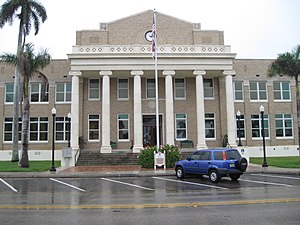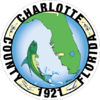|
Charlotte County, Florida
Charlotte County is a U.S. county located in southwestern Florida. As of the 2020 census, the population was 186,847.[2] Its county seat is Punta Gorda.[3] Charlotte County comprises the Punta Gorda, FL Metropolitan Statistical Area, which is included in the North Port-Bradenton-Sarasota Combined Statistical Area. HistoryCharlotte County was established April 23, 1921. It was named for the Bay of Charlotte Harbor. "Charlotte" came from "Carlota" (Spanish). In 1565, the Spanish named "Bahia de Carlota", followed by the English in 1775 who named the area Charlotte Harbor in tribute to Queen Charlotte. Punta Gorda is the only incorporated city in Charlotte County. On August 13, 2004, Charlotte County, Hurricane Charley came ashore near Port Charlotte as a Category 4 hurricane. On September 28, 2022, Charlotte County was struck by Hurricane Ian, which made a second landfall near the city of Punta Gorda, Florida.[4] Historic placesThere are seventeen properties and districts in Charlotte County listed on the National Register of Historic Places. Most of the officially recognized places are in Punta Gorda, Placida, and El Jobean. Additionally, there are numerous places generally considered historic despite not being officially listed as such, including the Old Charlotte County Courthouse, the Blanchard House Museum, and Port Charlotte Middle School. Port Charlotte Middle School (originally Port Charlotte Junior High School) was recognized by the Florida Trust for Historic Preservation as an endangered historic site for their annual 11 to Save properties following Hurricane Ian.[5] The school was further evaluated by the Florida Division of Historical Resources, which determined it is "potentially individually eligible for inclusion in the National Register of Historic Places" and "an excellent example of educational institution architecture during the 1970s."[6] In 2024, the Blanchard House Museum was named one of the Florida Trust's 11 to Save, also having been affected by Hurricane Ian.[7] GeographyAccording to the U.S. Census Bureau, the county has a total area of 858 square miles (2,220 km2), of which 680 square miles (1,800 km2) is land and 178 square miles (460 km2) (20.7%) is water.[8] Charlotte Harbor Estuary is an important natural preserve and one of the most productive in Florida. The Punta Gorda, Florida Metropolitan Statistical Area, consisting of Charlotte County, was defined by the U.S. Office of Management and Budget in 1992.[9] Adjacent counties
National protected areaDemographics
As of the 2020 United States census, there were 186,847 people, 79,789 households, and 51,016 families residing in the county. As of the census[19] of 2010, there were 159,978 people, 73,370 households, and 44,130 families residing in the county. The population density was 234 people per square mile (90 people/km2). There were 100,632 housing units at an average density of 115 per square mile (44/km2). The racial makeup of the county was 90.05% White, 5.68% Black or African American, 0.26% Native American, 1.19% Asian, 0.04% Pacific Islander, 1.10% from other races, and 1.67% from two or more races. 5.76% of the population were Hispanic or Latino of any race. 92.3% spoke only English at home. 3.0% of the population spoke Spanish at home and 1.1% French. There were 73,370 households, out of which 17.66% had children under the age of 18 living with them, 59.20% were married couples living together, 7.20% had a female householder with no husband present, and 30.90% were non-families. 26.00% of all households were made up of individuals, and 16.70% had someone living alone who was 65 years of age or older. The average household size was 2.18 and the average family size was 2.56. In the county, the population was spread out, with 14.30% under the age of 18, 5.38% from 18 to 24, 6.99% from 25 to 34, 39.21% from 35 to 64, and 34.12% who were 65 years of age or older (making this the county with the highest percentage of people over 65 in America). The median age was 56.43 years. For every 100 females there were 94.58 males. The median income for a household (2007-2011) in the county was $45,112; median income for families (2007-2011) was $47,415. Males (2011) had a median income of $27,352 versus $26,861 for females. The per capita income for the county was $28,875. About 5.30% of families and 11.9% of the population were below the poverty line, including 17.40% of those under age 18 and 5.60% of those age 65 or over. According to an October 2001 Census Brief of the 2000 Census, Charlotte County had the highest median age of any U.S. county with a population of more than 100,000 people at 54.3.[20] The median age in 2010 for Charlotte County was 55.9 years, second only to Sumter County in Florida. Government and politics The county is governed by a five-person Commission, all of them elected to represent districts within the county for a four-year term. The elections are partisan according to political party affiliation and primaries are held months earlier in the event there are numerous candidates. All registered voters in the county are allowed to vote for a candidate Commissioner in each the five districts, not just the voters living in a particular district. The five current Commissioners for Charlotte County, Florida and terms of office expirations:
Charlotte County, as is typical for the southwestern Florida coast, became and remained a solidly Republican county in the years following the Second World War. No Democrat has won the county since Lyndon Johnson did so during his 1964 landslide,[23] the only time a Democrat has carried the county since Franklin D. Roosevelt in 1944. In the last 60 years, Bill Clinton in 1992 and 1996 was the only Democrat not being outvoted by an absolute majority due to the appeal of Ross Perot. Charlotte resisted George Wallace in the 1968 election to still return an absolute Republican majority, unlike several neighboring counties.
Voter Registration
EconomyCharlotte County attracted plentiful new commercial developers and companies in 2023, continuing the county’s growth trend of the last several years. Most of the building activity is taking place within industrial areas surrounding Punta Gorda Airport, as much of the rest of the county’s land is zoned for residential use, and the land that is zoned commercial outside the airport area has insufficient acreage to support large-scale projects.[26] Another program the Economic Development Department is working with is an affordable housing initiative called the “Live Local Act.” The program was created by the Florida Legislature to fund and incentivize workforce housing. “Affordable housing and workforce housing is an issue in Charlotte County, Sarasota County, Florida and the entire country,” he said. “People need someone where to live in order to work here.” CCED has been holding workshops with the county’s large employers like hospitals, the school district, Cheney Brothers or the Sheriff’s Office.[27] EducationFlorida SouthWestern State College maintains a campus in the county. Southern Technical College operates a campus in the county. Charlotte County Public Schools administers all public schools from kindergarten through twelfth grade. Western Michigan University operated a regional location in the county until August 2019 when they closed the school. AeroGuard Flight Training Center opened a flight school at the airport. The Airframe and Power Plant Program offered through Charlotte Technical College also operates at the airport. LibraryThe Charlotte County Library System consists of 4 library branches.[28]
The erection of the first library was in 1963.[29] In 1976, Charlotte County and Glades County joined to make the Charlotte-Glades Library System. One reason the counties paired together was due to the additional $50,000 in state aid to libraries who join to serve the public. Charlotte County was financially responsible in the relationship. In 2008 the two counties separated and reverted to providing services to residents and visitors of their own communities.[30] The newest addition to the library system was an expansion to the Englewood Branch; the new building created is an additional 6,500 square feet. This provides more space for the youth services department, a new computer lab, and an archives run by the historical department.[31] CommunitiesCityCensus-designated places (unincorporated)Other unincorporated communities
TransportationAirportMajor highwaysSee alsoNotesReferences
External links
|
|||||||||||||||||||||||||||||||||||||||||||||||||||||||||||||||||||||||||||||||||||||||||||||||||||||||||||||||||||||||||||||||||||||||||||||||||||||||||||||||||||||||||||||||||||||||||||||||||||||||||||||||||||||||||||||||||||||||||||||||||||||||||||||||||||||||||||||||||||||||||||||||||||||||||||||||||||||||||||||||||||||||||||||||||||||||||||||||||||||||||||||||||||||





